What are abbreviations, acronyms and initialisms?

This is the first of three chapters about Abbreviations. To complete this reader, read each chapter carefully and then unlock and complete our materials to check your understanding.
– Introduce the concept of abbreviations and their types
– Discuss the purpose of using abbreviations in academia
– Outline three key rules for using abbreviated word forms in an academic context
Before you begin reading...
-
video and audio texts
-
knowledge checks and quizzes
-
skills practices, tasks and assignments
Chapter 1
Although abbreviated word forms are common in every language, English in particular has developed an overwhelming number of abbreviations for speakers to learn and use in their daily lives. Abbreviations are now in fact considered to be a major aspect of the English writing system, with the largest dictionaries of abbreviations containing many hundreds-of-thousands of examples and entries. With so many abbreviations on offer and so much variation in how to correctly abbreviate the original expressions, it’s unsurprising that non-native learners of English report becoming confused with this type of word structure. But what is an abbreviation exactly, and how are these structures used specifically in academia?
This short three-chapter reader first introduces the general concepts of abbreviations before categorising these structures in Chapter 2 into their seven different types and providing exploration of the relevant rules of pronunciation, punctuation and pluralisation. Finally, Chapter 3 offers a comprehensive list of the most useful abbreviations and their meanings for the studious English academic.
What is an abbreviation?
The word ‘abbreviate’ means to shorten, and so an ‘abbreviation’ is when either a word, phrase or longer piece of text has been reduced in length. Whether it’s an acronym, a contraction, an initialism or a logogram, there are many different types of abbreviation in use in the English language today:

Some abbreviations such as the initialism ‘WHO’ are quite formal and are perfectly acceptable in academic writing, while others such as the acronym ‘lol’ are commonly found in more informal contexts – such as in internet forums or when texting a message between friends. As will be explored in detail in Chapter 2, abbreviations such as these should be avoided when writing university-level assignments.
What is the purpose of an abbreviation?
Writing can be a time-consuming process and writers are always looking for ways to cut corners without reducing communication quality. For the words and phrases that require frequent repetition throughout your text, the simple act of abbreviating them may save time and words, which is certainly valuable during a university assignment that has time restrictions or a tight word count. It is worth noting however that although these may be the original reasons for their creation, some abbreviations have now become so common that few people remember their original forms. The following table highlights four such examples:

How are abbreviations used in academia?
While abbreviations are certainly acceptable in academic texts such as student assignments and journal articles, the range of abbreviations on offer to academics are much more limited. Many abbreviations (particularly those used on the internet or for the purposes of instant messaging) are considered to be too informal to be appropriate for use in academic English. But how can a student know which abbreviations are acceptable?
The general advice here is to be cautious. If you’re unsure of whether to use an abbreviated word form and can’t find the answer clearly online, try using the full form instead. If, however, you do decide to use one or many abbreviations in your text, then consider remembering and following these three important guidelines:
1) If the abbreviation is obscure or is unlikely to be familiar to the audience, make sure to explain that abbreviation clearly the first time it’s used:

2) As has been bolded in the previous example, whenever an important abbreviation such as this is first introduced to the reader in an academic text, the original expression should be written out in full and the abbreviated form placed directly after it in brackets. After introducing both forms, students are then advised to use the abbreviation for every subsequent mention of that term.
Please note that Guideline 2 should also be followed when introducing common abbreviations, such as well-known government agencies (Central Intelligence Agency (CIA)), organisations (World Trade Organization (WTO)) and companies (British Broadcasting Corporation (BBC)).
3) Finally, if an academic assignment contains many abbreviations, the author should consider placing a table of abbreviations before the start of their text.
Having discussed the basics concepts of abbreviations and how they’re used in academic writing, Chapter 2 next deals with exploring the seven types of English abbreviation and their various rules. Continue reading if you wish to learn more.
Downloadables
Once you’ve completed all three chapters about abbreviations, you might also wish to download our beginner, intermediate and advanced worksheets to test your progress or print for your students. These professional PDF worksheets can be easily accessed for only a few Academic Marks.
Collect Academic Marks
-
100 Marks for joining
-
25 Marks for daily e-learning
-
100-200 for feedback/testimonials
-
100-500 for referring your colleages/friends